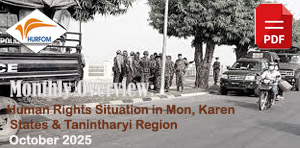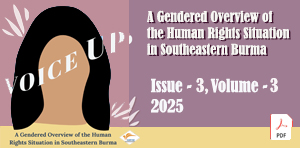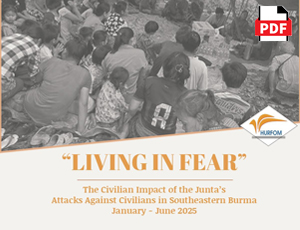Residents Forced to Construct Military Barracks for Border Guard Forces’ (BGF) troops in Myawaddy District, Karen State.
March 29, 2011
In early February 2011, the Captain of Military Operation Management Command (MOMC) No. 5, under the Southeast (SE) Command Military Operation, ordered ethnic Karen villagers to do loh-ah-pay[1] in the form of barracks construction for former Democratic Karen Buddhist Army (DKBA) troops now turned Border Guard Force (BGF). The buildings built for the BGF army battalions include the captain’s office, military barracks, officers’ hostels, long-low buildings with collection rooms, garages, and ordinance stores. Though the central government has allocated funds for the construction of those buildings, villagers forced to do loh-ah-pay are not only unpaid, but are obligated to provide their own supplies as well. Read more
Young women and elderly forced to Porter in Kawkereik Township, injuries result
March 15, 2011
Residents of Kawkareik Township have been pressed into service as porters by the Burmese army Infantry Battalion (IB) No. 32. According to residents, porters included young women and youth who were forced to carry supplies to the top of a nearby mountain to a forward unit base of IB No. 32. While porters were able to return the same day, some have suffered injuries from the extreme loads and steep uphill climb. This brief highlights the State Police and Development Council (SPDC)’s continued use of forced labor which is classified as a crime against humanity, and highlights how even the most basic forced labor is a danger to the victims involved. Read more
“Sitting on the fire”: forced labor demands during Kanbauk to Myaing Kalay Pipelien expansion
March 13, 2011
Introduction
In early January 2011, large steel pipes were delivered to villages along the Kanbauk to Myaing Kalay gas pipeline in southern Burma. The delivery of the pipes marked the first step in a larger process currently undertaken by the Burmese government operated Myanmar Oil and Gas Enterprise (MOGE), to expand the capacity of the pipeline.
The introduction of this expansion project marks a significant potential point of increase in the ongoing abuses committed by Burmese soldiers against local civilian communities. The proposed pipeline expansion has begun a labor intensive campaign in which residents excavate and extract the current 20” diameter pipes, and in some cases re-direct and dig the pipeline route so that the new 30” diameter pipes can be installed. Additionally, these laborers are used to guard the new pipe segments prior to installation, portions of the pipeline that will be replaced, build bamboo cover for exposed pipes, and re-bury and cover pipes. Civilians along the pipeline, who often live in significant poverty, are nonetheless used to perform a large portion of the labor during this process without compensation of money or food, and no regard for health or the impact that such extended forced labor would have on community livelihoods. Download report as PDF [324KB] Read more
Minority Rights in Ethnic States of Burma
March 12, 2011
According to the new constitution, Burma is divided into 7 Burman dominated Divisions and another 7 ethnic States for Kachin, Karen, Chin, Shan, Karenni, Mon, and Arakanese areas with some special ethnic regions for the Wa and others. Although the recent military regime pretended to form an ethnic Union of Burma, a real union would provide equal rights to all ethnic nationalities in the country. Read more
Authorities in Ye Township seize land ostensible for community development; development remains absent
March 4, 2011
HURFOM, Feb.28.2011, Southern Ye Township: Residents in Southern Ye Township, Mon State, are facing efforts by local village headmen and staff, to seize farmlands owned by local residents. These are being ostensibly sold for raising funds for community development. Residents whose land is has already been seized describe being upset and explain the effort as a ploy to provide extra income for the village head and staff. They also note that none of the promises of community development or public services have been met. While residents whose lands has been taken reported the seizer to District and Township authorities, no response has yet occurred. This seizure appears to signify a growing trend in which land seizure under the guise of community and economic development is on the rise.[1] Read more



















































